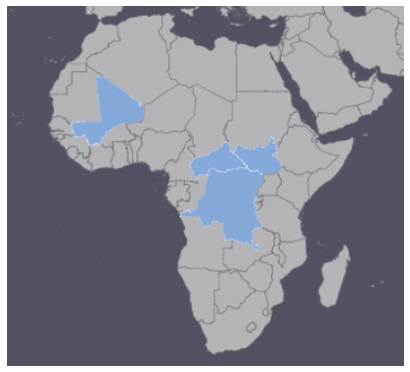Borrower Overview
TriLinc has provided financing to an international development logistics provider, operating out of Italy, that provides technical assistance, procurement, and trading services for projects and programs administered by well-known international development organizations throughout Sub-Saharan Africa, Eastern Europe, South America, and the Caribbean. The company works through projects financed by grants and loans from bilateral and multilateral organizations including the United Nations, the European Commission, and the Italian Ministry of Foreign Affairs’ Directorate General for Development Cooperation.
TriLinc’s financing will be utilized by the borrower to finance the export of unassembled, prefabricated portable housing and office modules for use by UN Peacekeeping missions in Sub-Saharan Africa. The company plans to enter into new markets in Sub-Saharan Africa through supplying prefabricated housing, wastewater management equipment, and medical goods and related services to UN peacekeeping operations throughout the region.
Market Overview

Although Italy is a high-income country,1 an exception was made for this borrower’s high impact through trade finance in multiple countries that meet TriLinc’s standards for its performance across relevant growth, stability, and access metrics.2 The global prefabricated buildings market was valued at $90.1 billion in 2012, with the European market making up $31.5 billion of this amount, and Italy specifically accounting for the largest share at 25.4%.3 The global demand for prefabricated housing is forecasted to increase 2.7% per year through 2019 to 3.4 million units.4 Global market drivers for prefabricated housing include housing energy savings benefits, space constraints in large, growing cities, and the global green building trend.5
More specifically, African countries are going through a period of rapid urbanization, resulting in high housing demand and the proliferation of makeshift, informal settlements. International development organizations, such as the United Nations, have the potential to help mitigate the pressure of urban expansion in the areas that they operate by providing access to affordable, easily assembled prefabricated housing to personnel stationed in-country. Sub-Saharan Africa has benefited from an estimated $38.6 billion in foreign direct investment that flowed into the region in 2016.6 Robust domestic demand across Sub-Saharan Africa has helped spur regional GDP growth to 1.3% in 2016, which is projected to strengthen to 3.5% by 2019.7
Additional Sustainability & Impact Highlights
- The borrower’s pre-fabricated housing modules are built in accordance with the ISO 14001- Environment Management System certification to reduce environmental impact, particularly when in use, through energy-saving measures that consist of using thermally efficient casing; construction methods designed to take advantage of solar energy, shade, and natural ventilation of the internal spaces; and the use of solar power to produce sanitary hot water.
- Through the UN contract, the borrower has been able to indirectly support jobs in-country, as assembling one module requires six people working for a full day. Additionally, the transport of modules to their final destination has generated work for the local freight forwarding companies.
- For its employees, the borrower offers health and disability insurance, paternal leave, and retirement provisions and maintains policies for fair hiring & recruiting, fair career advancement, and fair compensation.
1The World Bank, World Development Indicators Database, United Kingdom, 2There is no assurance that our investment in this company or this market will be successful. 3Global Prefabricated Building Market to 2017: Industry Analysis, Size, Shares, Growth, Trends and Forecast 2017 Research Report, 2017. 4On the Market Blog, Global Demand for Prefabricated Housing, 2016. 5Global Industry Analysts, Inc, The Global Prefabricated Housing Market: Trends, Drivers & Projections, 2015. 6The World Bank, Data, Sub-Saharan Africa, 2016. 7The World Bank, Global Economic Prospects, June 2017.
The above information is as of the initial date of investment: April 13, 2016.
TriLinc originally performed an SDG mapping exercise in December 2017 to map all of our borrower companies, both current and exited from our portfolios, to specific SDGs based off of business activity. TriLinc’s official SDG alignment methodology was not finalized until June 30, 2018. For borrowers that had exited TriLinc’s portfolios prior to this time period, the selected SDGs for these borrower are a reflection of what TriLinc believes would have been the SDG alignment if 1) the SDGs had been in effect and 2) TriLinc had integrated the SDG alignment while the company was in the portfolio. The SDG mapping presented does not include input from Investment Partners or borrower companies given that the companies were no longer in the portfolio when the alignment was finalized.
This borrower is no longer a TriLinc fund investment.
An investment with TriLinc carries significant fees and charges that will have an impact on investment returns. Information regarding the terms of the investment is available by contacting TriLinc. This is a speculative security and, as such, involves a high degree of risk. Investments are not bank guaranteed, not FDIC insured and may lose value or total value. Some investments may have been made in an investment vehicle that is no longer open for investment. The highlighted investment may or may not have been profitable. There is no guarantee that future investments will be similar.
Want to learn more? Contact Us.
